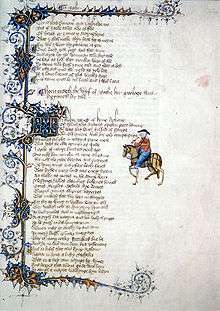Fleuron (typography)
| ❧ | |
|---|---|
|
Fleuron | |
A fleuron (/ˈflʊərɒn,
History
One of the oldest typographic ornaments, in early Greek and Latin texts, the hedera was used as an inline character to divide paragraphs, similarly to the pilcrow.[4] It can also be used to fill the white space that results from the indentation of the first line of a paragraph,[5] on a line by itself to divide paragraphs in a highly stylized way, to divide lists, or for pure ornamentation.[6]
In more modern historic books, line breaks became more common as paragraph dividers, and fleurons became popular to create ornamented borders. Fleurons were crafted the same way as other typographic elements were: as individual metal sorts that could be fit into the printer's compositions alongside letters and numbers. This saved the printer time and effort in producing ornamentation. Because the sorts could be produced in multiples, printers could build up borders with repeating patterns of fleurons.
In 1922, typographer Stanley Morison founded the Fleuron Society, that was to publish a lavish typographical magazine The Fleuron (1923–1930).
Use with computers
Designers continue to produce fleurons for use in digital typefaces.
Commercial
- Hoefler Text, by Hoefler & Frere-Jones[7]
- ITC Bodoni Ornaments, at Linotype and included with Mac OS X[8]
- Fleurons Granjon, a Lanston font at P22 type foundry[9]
- Monotype Goudy Sorts, at Linotype[10]
- Printers Fleurons, by Gerald Giampa, a Lanston font at P22 type foundry[11]
- Requiem, by Hoefler & Frere-Jones[12]
- Rieven type family, by Steven Skaggs, at Delve Fonts[13]
Free
- IM Fell Flowers, an open-source release of the Fell Types preserving the irregularities of the original 17th-century designs.[14]
- Horta contains several ornaments with a science fiction motif[15]
Unicode
In Unicode standards, the Symbols category includes fleurons referred to as "floral hearts" in the Dingbats and Miscellaneous Symbols blocks:
-
U+2766 ❦ floral heart (HTML
❦) (Dingbats) -
U+2767 ❧ rotated floral heart bullet (HTML
❧) (Dingbats) -
U+2619 ☙ reversed rotated floral heart bullet (HTML
☙) (Miscellaneous Symbols)
Twenty-four fleurons originally found in the Wingdings and Wingdings 2 fonts have been included in Unicode 7.0 under its new Ornamental Dingbats block.
| Ornamental Dingbats[1] Official Unicode Consortium code chart (PDF) | ||||||||||||||||
| 0 | 1 | 2 | 3 | 4 | 5 | 6 | 7 | 8 | 9 | A | B | C | D | E | F | |
| U+1F65x | 🙐 | 🙑 | 🙒 | 🙓 | 🙔 | 🙕 | 🙖 | 🙗 | 🙘 | 🙙 | 🙚 | 🙛 | 🙜 | 🙝 | 🙞 | 🙟 |
| U+1F66x | 🙠 | 🙡 | 🙢 | 🙣 | 🙤 | 🙥 | 🙦 | 🙧 | 🙨 | 🙩 | 🙪 | 🙫 | 🙬 | 🙭 | 🙮 | 🙯 |
| U+1F67x | 🙰 | 🙱 | 🙲 | 🙳 | 🙴 | 🙵 | 🙶 | 🙷 | 🙸 | 🙹 | 🙺 | 🙻 | 🙼 | 🙽 | 🙾 | 🙿 |
Notes
| ||||||||||||||||
Gallery
 Early printers sought to use fleurons to replicate the style of manuscripts like this one.
Early printers sought to use fleurons to replicate the style of manuscripts like this one. Specimens of printed floral borders from an 1897 type foundry specimen book.
Specimens of printed floral borders from an 1897 type foundry specimen book. Example fleuron glyphs from a digital font.
Example fleuron glyphs from a digital font.
References
- ↑ "fleuron". Collins English Dictionary.
- ↑ "Fleuron | Define Fleuron at Dictionary.com". Dictionary.reference.com. Retrieved 2013-12-24.
- ↑ Bringhurst, Robert, The Elements of Typographic Style, Second edition: Hartley and Marks Publishers, 1996. ISBN 0-88179-132-6
- ↑ "History of Graphic Design: Rare Books Collection: The Pilcrow". Mikemichelleapril.blogspot.com. 2008-09-29. Retrieved 2013-12-24.
- ↑ "Typographic Marks Unknown – @retinart". Retinart.net. Retrieved 2013-12-24.
- ↑ Archived October 29, 2013, at the Wayback Machine.
- ↑ "Hoefler Text Font Features: Special Characters | H&FJ". Typography.com. Retrieved 2013-12-24.
- ↑ "Download". Linotype.com. Retrieved 2013-12-24.
- ↑ "LTC Fleurons Granjon". P22.com. Retrieved 2013-12-24.
- ↑ "Download". Linotype.com. Retrieved 2013-12-24.
- ↑ "Lanston Font | Printers Fleurons C | Printers Borders". P22.com. Retrieved 2013-12-24.
- ↑ "Requiem Font Features: Ornaments | H&FJ". Typography.com. Retrieved 2013-12-24.
- ↑ "Fonts and Type Design – Rieven Uncial, A typeface designed by Steven Skaggs". Delve Fonts. Retrieved 2013-12-24.
- ↑ Marini, Igino. "Fell Types". Retrieved 1 December 2014.
- ↑ "Horta". Retrieved 2018-02-12.
External links
| Wikimedia Commons has media related to |